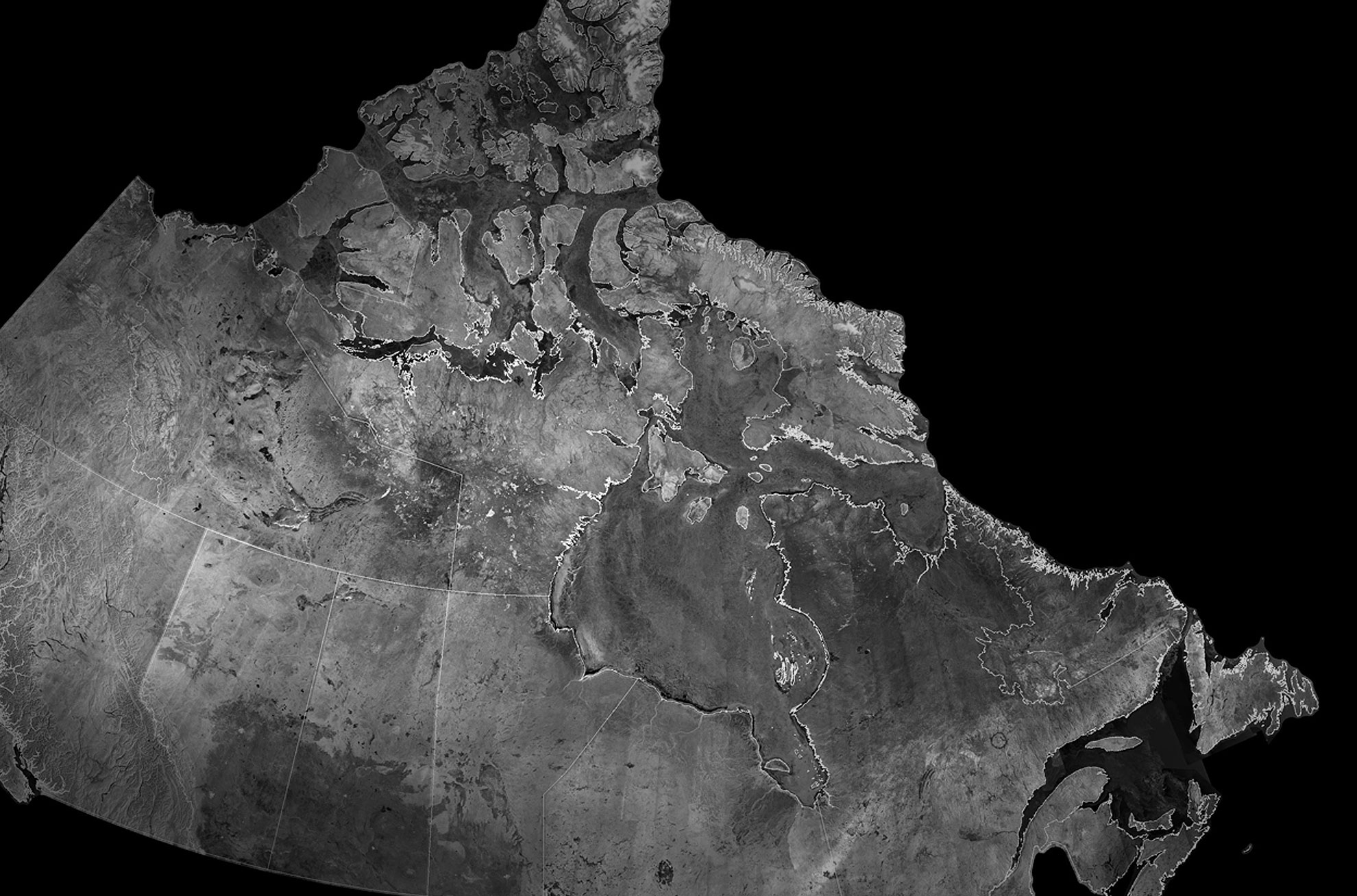
Canada
From Space
Introduction
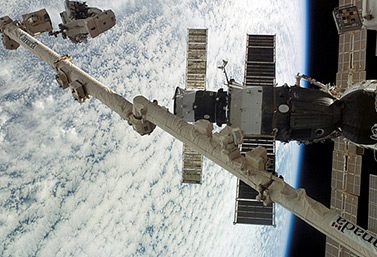
On August 13, 2007, Canadian astronaut Dave Williams is secured to the Canadarm while doing maintenance work at the International Space Station.
(NASA/Associated Press)In the early sixties, two factors resulted in Canada becoming the third country to reach space.
First, Canada needed to improve telecommunications so people could connect more easily. Second, exploring space had become a tool for economic development.
Already in the fifties, Canada was striving to build its first major ground-based telecom network. The plan was to erect over 100 transmission towers countrywide.
The fifties also saw the construction of the Alert base, which is still the northernmost inhabited place on Earth (only 817 kilometres from the North Pole). Located in Nunavut in Canada’s Arctic, this weather station set up in 1950 lies next to a military base built in 1958.
Dangers of an aurora borealis
The fifties were also a time when Canadian engineers became concerned about the aurora borealis. As an aurora crosses the ionosphere, it seems to have a mysterious effect on radio transmissions and, sometimes, a catastrophic effect on the major power grids.
People noted that major blackouts coincided with intense periods of auroral activity. The only way to clear up the mystery was to investigate directly in space.
A science fiction story
In 1945, 17 years before Canada first ventured into space, British science fiction writer Arthur C. Clarke predicted that Earth would one day be circled by artificial satellites that would remain in orbit at a fixed distance from the planet and be used as communication channels.
Fifteen years later, the idea of using satellites to enable conversations between citizens caught the imagination of a handful of scientists in the United States and the Soviet Union. Unfortunately, the two countries were involved in a space race whose aims were mostly military.
Civil applications for satellites seemed obvious to the Canadian government. In 1958, one year after Sputnik, the Department of National Defence received orders to build the first Canadian satellite and send it into space.
Alouette 1, first Canadian satellite

In 2019, three new satellites of the RADARSAT Constellation were launched aboard a Falcon 9 rocket belonging to the private company SpaceX. The three satellites together provided new observation capabilities for the country and the planet. The three satellites, all identical, are to replace the aging RADARSAT-2 spacecraft.
(Canadian Space Agency)Alouette 1 was launched in 1962. Its mission was to study the ionosphere, where many future satellites would be put into orbit. Canada became the third country, after the Soviet Union and the United States, to send a satellite into space. Alouette 1 amazed the world because it was the very first geostationary satellite.
The whole world applauded Canada’s ingenuity and wondered how this small country, with fewer than 19 million people back then, could accomplish such a phenomenal feat.
In actual fact, to send its satellite into space, Canada relied on an American military rocket. Later, it began using NASA rockets.
Hello! This is the North Pole. Do you read me?
In 1972, Canada sent up a satellite devoted exclusively to civil telecommunications. This was another world first, and Canada’s Far North was the first to benefit.
The public broadcaster CBC/Radio-Canada used the satellite to broadcast its programs in colour. Radio and telephone communications with the south of Canada were no longer disrupted during bad weather. The satellite, named Anik A1, was the first in a long line of Anik satellites. In Inuktitut, the language of the Inuit of Canada, anik means “little brother.”
In the nineties, thanks again to satellites, broadband Internet services began to be offered across Canada.

In 2019, three new satellites of the RADARSAT Constellation were launched aboard a Falcon 9 rocket belonging to the private company SpaceX. The three satellites together provided new observation capabilities for the country and the planet. The three satellites, all identical, are to replace the aging RADARSAT-2 spacecraft.
(Canadian Space Agency)The year 1995 saw the introduction of Radarsat, Canada’s first commercial remote sensing satellites. Equipped with powerful radar, they record images of Canada day and night to monitor the spread of forest fires and crops. They also locate promising prospecting areas.
The birth of the Internet
In the seventies, Canada partnered with private industry and started to design the famous Hermes satellites. Especially powerful, they paved the way for multichannel satellite television as it exists today in Canada and globally.
Canada’s space program is estimated to be among the top six to eight programs in the world. Yet there is one telecom sector where the country lags behind other industrialized nations: cellphone service.
Did you know?

Bell Canada headquarters in Montreal
(Ryan Remiorz/Canadian Press)Satellites drive Canada
Leading Canadian companies often rely greatly on the extensive use of satellites.
Bell Canada employs nearly 52,000 Canadians. It is the largest company in Quebec and Ontario, Canada’s most populated provinces.
TELUS is a major company in Western Canada and is particularly active in British Columbia and Alberta.
MTS Allstream is the largest company in Manitoba, in Central Canada.
SaskTel is the biggest company in Saskatchewan, also in Central Canada.
Invented by Canadians

Telemedicine is among the major inventions by Canadians.
(Radio-Canada)Telesurgery
The Americans and French claim to have invented remote medicine together. True, the first telesurgery occurred in 2001 in both New York City (where the surgeon was located) and Strasbourg (where the patient was located).
Still, Canadians have the honour of being the first to do a remote “medical procedure” using a satellite and cameras. On November 8, 1994, a medical team at Hôtel-Dieu in Montreal (one of Canada’s leading hospitals) examined a patient who was in Paris, France, at Hôpital Cochin. The patient was scanned with an X-ray machine despite his Canadian doctors being 5,900 kilometres away.
Telehealth is booming in Canada—but not in every province
Canada is among the countries today where telemedicine is the most developed. In the Far North, telemedicine is the backbone of services offered by health officials. Hospitals and doctors are often hundreds of kilometres away from the Inuit communities that receive their services. These communities, which are often tiny, are spread across a region as wide as Europe.
In orbit
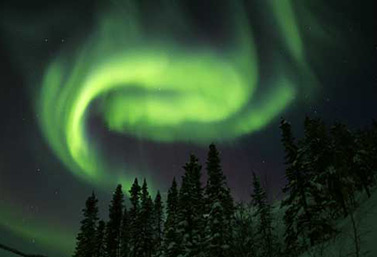
An aurora borealis can be seen regularly in the skies of Yellowknife in the Northwest Territories.
(James Pugsley/Astronomy North)Voyage to the centre of an aurora borealis
The northern lights were one of the main reasons Canada began exploring space. These curtains of colour that stretch across the night sky are dazzlingly beautiful, but, for the Canadian government in the late fifties, they were also a threat.
Northern lights common in Canada
Auroras are caused when solar wind particles interact with the upper atmosphere. They occur mainly in areas close to the poles, in the auroral zone (between 65 and 75 degrees latitude).
An aurora borealis can be seen at night in three areas of the world: northern Scandinavia, northern Alaska and northern Quebec (Nunavik). In these regions, auroras are visible almost every night.
In lower latitudes, like in Ottawa, Canada’s capital, solar flares must last a long time before northern lights will appear across the sky.
Auroras can be observed one to three times a month even in lower latitude areas like Montreal, especially in winter.
The solar activity cycle responsible for auroras is spread over 11 years. At the peak of the cycle (in 2013, 2024, 2035, etc.), auroras are more vivid and more common.
Extensive research into the upper atmosphere
During intense solar storms, radio wave communications are scrambled or disrupted because the waves travel in the upper atmosphere where the northern lights lurk.
In the forties, Canadian scientists began reporting that the northern lights were causing power failures and extensive radio interference. For example, discharges of static electricity around transmission towers were strong enough to destroy safety devices and damage transformers.
Even back then, scientists realized that polar auroras changed the behaviour of the magnetosphere, which in turn disrupted the operation of satellites. Certain satellites lost all means of communication with Earth for days. The intense flow of protons and electrons from auroras penetrated satellites and could alter the data contained in their onboard computers.
Electric currents produced by auroras can cause telephone cables to malfunction by changing their tension. When this occurs, a telephone emits background noise.
It took many years to reveal, mainly thanks to Canada, all the dangers and mysteries of the northern lights.
In the sixties, Canada sent up a series of satellites carrying auroral imagers, magnetometers and ionospheric radars to better understand how auroras affect radio transmissions and the weather. Drawing on this research, Canada was able in the seventies to launch a large ring of communication satellites that were better protected against the dangers of the northern lights.
A great story

On the way to Saint-Gédéon, Lac-Saint-Jean, the northern lights dance in the sky during the summer of 2018. PHOTO: LAURENT SILVANI
Legends about the northern lights
The Inuit of Northern Canada once believed they could see the spirits of animals like salmon, seals and belugas dancing in the auroras. Their shamans or medicine men claimed they took spiritual journeys through the auroras in search of ways to cure the sick.
The Algonquins also have a legend explaining how an aurora borealis is created. According to this myth, once Earth’s creator finished his work, he returned home to the north. There he made huge bonfires to remind humans he would not forget them. An aurora is supposedly the reflected light coming from the fires made by the great creator.
When certain Inuit groups observe an aurora, they see the spirits of the dead playing ball with walrus heads or skulls. The Inuit of Nunavik in northern Quebec see the opposite: the spirits of walruses playing with human skulls.
Did you know?
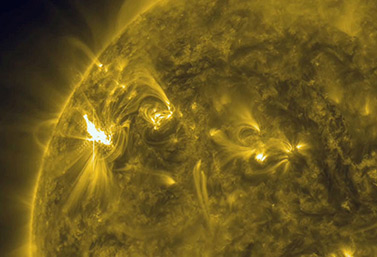
Close-up of the Sun and solar activity.
(NASA/SDO)Solar Maximus
Over 100 years ago, Canadians already suspected a link between the northern lights and the Sun. Lumberjacks and farmers took auroras into account when making weather forecasts.
Some claimed that auroras meant good weather to come. Others believed the opposite: that auroras heralded high winds and storms.
Not until a NASA mission in 2007 was the record set straight: auroras have no real impact on the weather, but their behaviour is far more affected by the Sun than once believed.
The THEMIS international mission, which Canada took part in, sent a probe in February 2007 to the region where most auroras form. Scientists learned that the light display resulted from magnetic explosions occurring at a third of the distance separating Earth from the Moon. These discharges of energy are caused by “reconnections” between the giant magnetic ropes linking Earth to the Sun, ropes that store the energy from solar wind.
By the numbers: 100 to 1,000 kilometres
Auroras sometimes seem to occur at the same height as the clouds in the atmosphere. But they are in fact located in the ionosphere, a band that unfurls at a distance of 100 to 1,000 kilometres above Earth’s crust.
In comparison, the space shuttle travels at an altitude of just over 300 kilometres.
However, auroras can sometimes form at an altitude as low as 60 kilometres or as high as 2,000 kilometres.
Watch
The northern lights dance across the Yukon skies
Aurora borealis seen from the International Space Station
Canadian satellites have their eye on you
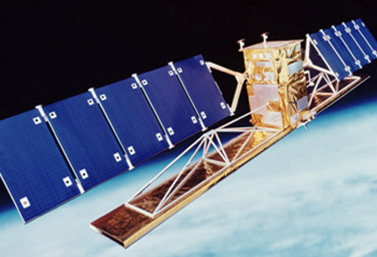
Launched in November 1995, RADARSAT-1, Canada’s first Earth observation satellite, is able to transmit and receive signals despite clouds, fog, smoke and darkness.
(Canadian Space Agency)Today, as the polar ice cap continues to melt, Canadian satellites like RADARSAT-1 and RADARSAT-2 are extremely important for monitoring environmental changes. They also watch over ships in northern waters to ensure their safety. In addition, they conduct a series of missions that would be impossible to carry out otherwise.
Among these missions, they detect oil spills in the Atlantic Ocean, where Canada has exploited vast oil deposits since the mid-eighties. The satellites map different areas: land affected by drought, coastlines suffering erosion, crops infested by insects, territories of migratory animals threatened by predators, and forests ravaged by fires.
Canada is among the first countries that became accustomed to seeing the world from space via satellite images.
Contact lost with Manitoba
Canada cannot make do without satellites. Indeed, in Canada, it has never been easy to communicate over distances. Several times in the 18th and 19th centuries, whole sections of Canada were cut off from the country and the rest of the world for weeks. Snowstorms and avalanches were the main threats to communications. Even in good weather, the mountainous terrain often made ground-based telecommunications impossible, and the infrastructures were prohibitively expensive to maintain.
Often, there was simply no one around to make, maintain or repair the equipment. Canada has the eighth least dense population in the world. The density is even lower in the Far North, which accounts for 40% of Canada’s land mass. Indeed, there is not even one citizen every three square kilometres in this region.
Among developed nations, only Australia has a lower population density than our own. But Australia has no major rivers, great lakes or rugged mountain ranges, and nor does it have regions that are continually wind-swept or covered in ice or snow for over nine months a year. Our low density and landscape are the reasons that, in the late fifties, Canadians wanted to set up a telecom network like no other in the world.
Ongoing success
From 1963 to 1969, Canada joined forces with the United States for a joint experimental program called ISIS (International Satellites for Ionospheric Studies). One of the program goals was the transfer of technology.
Government scientists and technicians shared with their colleagues in the private sector the knowledge they had gained in the first phase of their research on space communications. RCA Victor, de Havilland Aviation and Spar Aerospace were the main Canadian and American companies taking part in the program.
Starting in 1967, Canada moved from the experimenting stage to practical applications and focused on launching its first domestic communication satellites. It also made its first attempts to gather data on the country’s natural resources.
Other key dates in space for Canadians
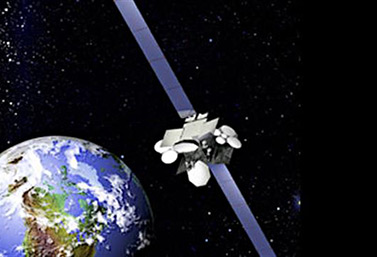
An image of the Anik F2 satellite, which encountered technical problems in 2010 causing serious telecommunication failures in Canada’s Far North.
(Telesat)In 1969, Ottawa created the company Telesat Canada to exploit its commercial satellite communication system, which it hoped to put into orbit.
As part of this new adventure, the satellite Anik A1 was launched in November 1972. It was followed by Anik A2 in April 1973. Canada had become a pioneer in the use of satellites for domestic communication purposes. A third satellite, Anik A3, went into orbit in May 1975.
In the early nineties, the launch of a series of new Canadian satellites marked the beginning of an era of high-powered communication satellites.
At the time, scores of Canadians began to access hundreds of television and radio channels through direct-to-home satellite broadcasting.
In 1992, after reaching its goal to encourage the introduction, development and use of satellites in commercial telecommunications, the Canadian government sold the controlling interests it held in certain companies that served as pioneers in the deployment of satellites.
Since then, new digital compression technologies for satellites have enabled Canadian consumers to receive a variety of commercial, information and entertainment services via the Internet.
Discover
Earth observation satellites. Canadian Space Agency
Read
Space officials confident of a major satellite launch in May – RCI
Watch
Observe space weather via a Canadian hybrid satellite
Invented by Canadians
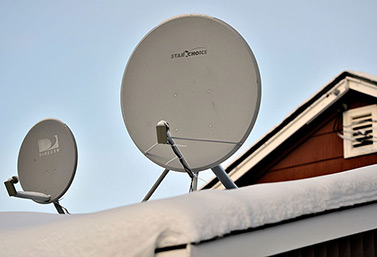
Satellite dishes to pick up television stations
(Ian Stewart/CBC News)Satellite television
It is fair to say that Americans had a hand in developing satellite television. Yet, from the start, Canadians were the driving force behind this invention that forever changed television.
From 1970 to 1979, Canada and the United States worked together on an experimental communication satellite system known as Hermes.
When launched in January 1976, Hermes was the world’s most powerful communication satellite.
Hermes was the first satellite to operate in the 14/12 GHz band. Thanks to this band and the power of the transponders, it was possible to use satellite dishes as small as 0.6 metres in diameter, specially designed for direct broadcasting of television signals to homes.
The Hermes program also included scientific applications, as well as experiments in telehealth, tele-education, community communications and the delivery of government services.
Commercial satellite television debuted officially in Canada in November 1982 with the launch of the Canadian satellite Anik C3 by the U.S. space shuttle Columbia.
Canadarm in space
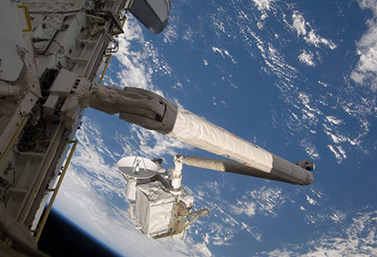
In this photo from July 21, 2009, the space shuttle Endeavour deploys the second-generation Canadarm.
(Canadian Press/NASA)In the past 30 years, Canada has gained expertise not only in geostationary satellites, but also in space robotics. As a result, NASA has relied on Canada to assist astronauts with their construction and repair work.
Canada has designed not one, but two giant arms (the first 15 metres long and the second 17 metres long). They are very thin, their diameter ranging from 33 to 35 centimetres.
Because they are white, these arms can be clearly seen in the dark space surrounding our planet. However, they are but one element in a very complex and less visible remote manipulator system designed by Canadians. This system also includes a hand device and a control station manned by an astronaut (usually a Canadian).
Canadarm1 and Canadarm2
These arms were designed by the Canadian company Spar Aerospace. The first, Canadarm1, was sent into space in November 1981 in the space shuttle’s cargo bay.
Canadarm2 was launched 20 years later, in 2001. Today, it is secured permanently to the International Space Station. It is a bigger and “smarter” version of Canadarm1. Weighing 1,600 kilograms, it is four times heavier than its predecessor.
The arm can lift over 60 times its weight. It has seven joints, one more than its older brother. One of its duties is to perform “cosmic catches,” the catching and docking of unmanned spacecraft that carry everything from scientific equipment to supplies for the six crew members aboard the International Space Station.
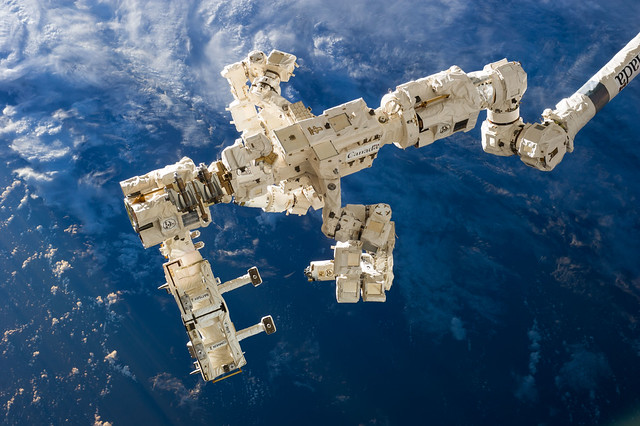
The Canadarm2 and Dextre of the International Space Station, also known as the Special Purpose Dexterous Manipulator (SPDM), were used to replace a defective main bus switching unit in 2019 and restore the station’s full power. Photo: NASA
Dextre, the handyman at the end of Canadarm
For over 20 years, Canadarm’s “hand” was small, and its dexterity fairly poor. The hand was a cylindrical end effector containing a three-wire noose that could, for example, capture a satellite encountering difficulty.
Dextre is the sophisticated new “dexterous” hand found at the end of Canada’s second-generation arm. In 2008, Dextre and Canadarm2 were used together for the first time.
Dextre itself has two small arms and seven joints, which turn it into a robot handyman. It contains sensors that give a human-like sense of touch to the astronaut operating it from the control station. It also has small retractable socket wrenches, a camera and lights.
The new polymer $5 bill, released in 2013, features Canadarm2 and Dextre.
Read
Canadian astronaut catches SpaceX capsule using Canadarm 2 – RCI
Watch
Dextre is put through its paces
Did you know?

The second-generation Canadarm is 17 metres long.
(Canadian Space Agency)The first Canadarm weighed under 450 kilograms (about the weight of five men) and could not support its own weight in normal gravity. During its development, it had to be laid on specially designed inflatable cushions.
Canadarm can move payloads of nearly 30,000 kilograms (about the weight of 15 large automobiles). It can manoeuvre objects into position with an accuracy of about five centimetres.
Each joint is powered by a motor driven by a servo-power amplifier.
The arm, which is made of titanium, stainless steel and graphite epoxy, is entirely covered by an insulation system made of layers of Kapton, Dacron and fibreglass.
The two Canadarms can be used in tandem in space. This technique is known as the “Canadian handshake.”
By the numbers

Marc Garneau, the first Canadian in outer space. He took part in three shuttle flights, including Challenger STS-41-G from October 5 to 13, 1984.
(Canadian Space Agency)4,300
In summer 1983, the National Research Council of Canada sought astronauts by placing a job ad in major Canadian newspapers. A total of 4,300 people applied.
Help wanted: six future astronauts
The ad said that the NRC was looking for men and women who were skilled at conducting scientific experiments, were comfortable speaking about science to the public, and were ready to embark on the most thrilling journey of their life—a trek into space.
The NRC was swamped with over 4,300 applications. They came from students, poets, journalists, engineers and scientists of all kinds.
The ad drew a strong response because Canadians of all ages were fascinated by space in the early eighties, even more so than today. The resounding success of Canadarm (the robotic arm developed under the NRC) on the space shuttle Columbia flights in 1981 and 1982 fuelled the enormous public interest.

In spring 1999, Julie Payette became the first Canadian woman in outer space.
(NASA)Did you know?

(Radio-Canada)
When the space shuttle Challenger exploded in 1985, the U.S. space program was temporarily put on hold. At the time, Canada decided to expand its own program.
Hence, the Canadian Space Agency was formed in 1989 with the main goal of training the first Canadian astronauts. For its part, the National Research Council focused on developing robot and satellite technologies.
Watch
A historic trip through Canadian space exploration with astronaut Chris Hadfield – CBC
Canada, greatest light pollution champ

A satellite image of North America. Montreal and Toronto, which are among the brightest cities on the continent, can be clearly seen in Eastern Canada.
(NASA)At night, the south of Canada when seen from space looks like a string of extremely bright pearls. Canada ranks among the four or five countries that are most visible from space at night.
Quebec City (300,000 people) causes as much light pollution as Boston (five million people) or the Paris region (12 million people).
As for the Montreal region (nearly three million people), it is as bright as the New York area (20 million people).
Whose fault is it?
Light pollution is due to the misuse or overuse of light. The biggest problem is globe-shaped street lamps that cast their light directly skyward. Some advertising signs and billboards also use overly bright light. Quebec is especially at fault because electricity is inexpensive here compared with other provinces and, as a result, Quebeckers are less vigilant about the amount of energy they use.
Shedding light on the problem
Light cast toward the horizon pollutes 2.7 times more than light cast toward the ground. In fact, a 1% increase in light cast near the horizon boosts light pollution by 25%. That is why programs to reduce light pollution generally recommend using street lamps that do not cast more than 2% of light above the horizon.
In addition, a good portion of light pollution in Canada comes from the snow that covers the ground several months a year. Snow reflects light skyward rather than absorbing it.
Some cities have taken steps to cut light pollution. They use low- or high-pressure sodium lamps, which produce light that is up to four times less bright. With this measure, Calgary in Western Canada has turned down the brightness of street lamps several notches (and saved several million dollars a year on electricity).
Did you know?
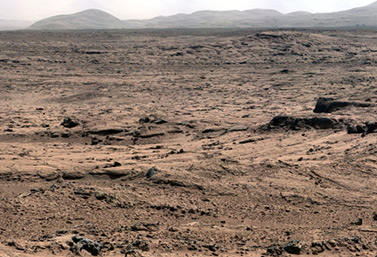
An image of Mars taken by the rover Curiosity in Yellowknife Bay.
(NASA)Yellowknife: in Canada and on Mars
The northern city of Yellowknife has lent its name to the most famous square kilometre of land on Mars. “Yellowknife Bay” is in fact where the U.S. robot Curiosity touched down in summer 2012.
There is a very good reason why the capital of the Northwest Territories (population: 20,000) shares its name with a patch of Martian land 250 million kilometres away. The ground near Yellowknife contains the oldest rock in the world—four billion years old—which is probably the same age as the Martian rock that Curiosity landed on.
Mining prospectors in Yellowknife are looking forward to the day when companies in their city can do business with the residents of Yellowknife Bay on Mars!
Telecommunications in the early days
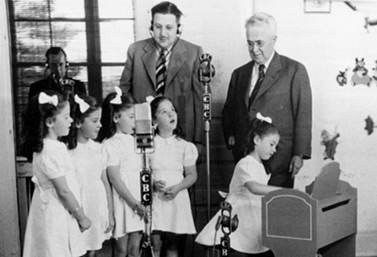
Radio in the twenties.
(CBC/Radio-Canada)Canadian telecommunications date back to a period long before satellites and electricity were invented.
On the wind-swept plains and prairies of Western Canada, Aboriginals lit fires and sent up smoke signals. This was virtually the only way to communicate over long distances before the telegraph came along.
Canada began receiving radio transmissions only in the twenties. Canadians counted themselves lucky because they were among the first—with the Americans, British, French and Italians—to experience the power of radio waves.
Canada among the first countries to experience radio
The Montreal station XWA (today CFCF) owned by the Canadian Marconi Company had the distinction of giving the first radio broadcast in North America, and possibly even the world. It occurred on May 20, 1920.
Outside cities, radio was broadcast on trains. In fact, in the twenties, radio waves generally travelled along railroads, just as telegraph wires had done a few years earlier. With a few exceptions, including Montreal, Toronto and Vancouver, the first radio was basically a railway service. It was mobile, but had little power.
Railway companies not only had the financial means to experiment with this new gadget, but also a captive audience, passengers forced to remain seated over long distances.
At the time, crossing Canada by train took up to 10 days. Railway companies were therefore looking for ways to entertain passengers.
In 1924, the Canadian National Railway Company (CN) began offering radio on almost all its long routes. It installed receivers to pick up broadcasts, which mostly came from the United States. Eventually it decided to build transmitting studios. This initiative culminated five years later in a transcontinental radio network linked by “landlines.” These famous lines, together with the lines of Canadian Pacific Railway, were the true ancestors of the telecom network in Canada.
Radio grows faster in the U.S.
By 1928, over 60 radio stations were operating in Canada. Most were low-power and offered only intermittent service. The sector was poorly regulated, which slowed the growth of radio in Canada compared with the boom in the United States. South of the border, radio broadcasting flourished thanks to businesses and corporations vying for airtime for their advertisements.
In Canada, advertising was initially forbidden, which deprived radio of revenue and slowed progress. Also, the government was unsure how to develop the medium.
Years of uncoordinated development
In the early days, many amateurs created their own short-range radio stations. A whole slew of popular and inexpensive “amateur hours” sprang up, even though they often bothered neighbours or caused interference. For many years, Canada’s Department of Marine and Fisheries had the power to issue or deny permits for radio stations. Yet it did not seem to grasp the importance of this new means of communication.
Canada’s golden age of radio
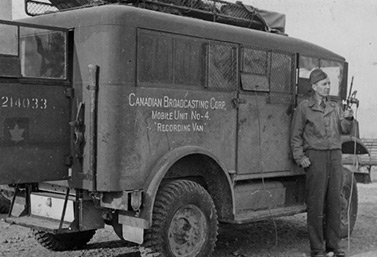
A CBC vehicle from the forties.
(CBC/Radio-Canada)The forties were the golden age of radio communications in Canada. The Second World War whetted people’s appetite for news. Canadians wanted to know what was happening around them, but they were also discovering the world. CBC News was founded in 1941, and Radio Canada International began operating in 1945. Programs about farming, like Le réveil rural in French were very popular.
Preventing media concentration
In Canada, radio is much more regulated today than in the past. It is a model that Berlusconi’s Italy could have draw inspiration from.
The Canadian government, through its CRTC regulatory agency, does not allow an owner to control more than four radio stations in major metropolitan markets and more than three in smaller markets. The rules are designed to prevent a single owner from dominating a local broadcasting market (including discretionary and over-the-air services) and from controlling all cable and satellite companies in a given market.
As for cross-media ownership, new rules were recently drawn up to prevent one entity from controlling more than two types of local media (radio, television, newspaper) serving the same market.
Did you know?

The Radio-Canada studio in Ottawa
(Patrick Pilon)Canada has the world’s most complex broadcasting system
- In 1979, the U.S. had 982 radio stations, while Canada, with a tenth of the population, had 1,045.
- In 1981, Canada had 1,225 radio stations.
- In 2013, Canada still has almost 1,200 radio stations.
- In 2017, there were 952 radio stations in Canada, compared to 830 in 2007.
- Today, Canadian radio covers seven time zones.
- Canadians can listen to radio over almost 10 million square kilometres.
- CBC/Radio-Canada is the only national public broadcaster.
- CBC/Radio-Canada operates almost 9% of radio services.
Invented by Canadians
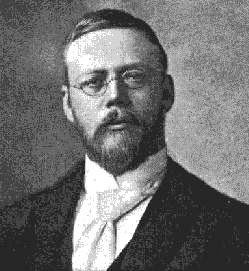
Reginald Fessenden
(Public domain)Radio is mostly a Canadian invention
Contrary to what old history books claim, Canadians, not Italians, are to be thanked for inventing radio. It was recently recognized that the Canadian Reginald Fessenden, not the Italian Guglielmo Marconi, was in fact the man behind the first radio transmission.
It is true that, in 1901, Marconi sent the first wireless telegraph message across the Atlantic from St. John’s, the capital of the future Canadian province Newfoundland. However, a year earlier, Reginald Fessenden, a Canadian inventor, had begun developing the first real radio wave transmission.
First, he transmitted the sound of a voice over an 80-kilometre distance. Six years later, in 1906, he repeated the feat over an amazing 5,000 kilometres, the distance between Boston and the Scottish coast. Fessenden aimed to make Canada a world centre for long-range radio transmission. But it was Marconi, with his stronger political ties, who was granted exclusive rights by the Canadian government to build the first transmitting stations in Canada.
Until recently, Fessenden’s name and his role as a great radio pioneer were largely unknown, even to Canadians.
Read
Canada’s broadcasting system is the world’s most complex. The Canadian Encyclopedia
Watch
75 years of broadcasting in Canada
Sixty years of Canadian television

PC/AP Photo/Ted S. Warren
In the fifties, the Canadian government oversaw the development of television with the clear aim of using it as a cultural safeguard against the influence of American media. Still today, the government monitors the industry closely and legislates to ensure that Canadian television and radio counterbalance what airs in the United States.
This goal is hard to achieve because over 85% of Canadians live in the southern part of the country. Preventing American airwaves from crossing the border is not easy. The Broadcasting Act (1968), however, is very clear in this regard. It states that the Canadian broadcasting system must be “owned and controlled by Canadians so as to safeguard, enrich and strengthen the cultural, political, social and economic fabric of Canada.”
Two major organizations: the CBC and the CRTC
Broadcasting space is a key political issue because radio and television are very effective means of bringing citizens together. That is why Canada continues to channel major funds into the largest public television network in democratic countries. It is also why it set up a powerful government agency to monitor the industry—the Canadian Radio-television and Telecommunications Commission. The CRTC rules on all kinds of issues: matters of good taste on radio and television, station ownership, number and location of stations, and conditions they can operate under.
The degree of control, which is unusual, sometimes criticized and often debated, seems nonetheless to reflect the importance Canadians attach to certain tools of development and well-being, which they want protected from the brute forces of capitalism.
In short, offering distinctively Canadian media that reflect the country’s values is as important as providing a free health care system. These matters are the foundations the Canadian identity is built on.
Coercive measures to protect Canada from the U.S.
In 1971, the CRTC imposed Canadian content requirements and percentages for popular music that remain the cornerstone of Canadian broadcasting regulations.
In 1998, the requirements increased. The weekly minimum for Canadian music rose to 35% from 30% for radio stations in English and to 65% from 55% for stations in French.
On prime time television, broadcasters must favour Canadian programs. To date, the CRTC considers its television and radio monitoring system a success. Programs with the most viewers are Canadian. On the English side, Canadian drama series are more accessible and popular than in the past.
After the threat of American TV, the danger of the World Wide Web
In the second decade of the 21st century, Canada’s bustling telecom sector is becoming even more crowded and complex. The question is whether Canadian media are still able to nurture a national identity distinct from the American identity and, by extension, whether French speakers in Canada can preserve their identity in a world increasingly dominated by the English language. The tech boom is transforming broadcasting practices and making cultural borders porous.
The next chapter in affirming the Canadian identity will probably play out on the web. Unfortunately, the CRTC has little jurisdiction over this tool used to transmit culture.
Recently the CRTC was widely criticized, especially by the Canadian government, for trying to rule in areas where the interests and needs of Canadian Internet users were not properly considered.
This lack of contact between the Internet and CRTC officials is a potentially serious shortcoming. The web, which is growing at lightning speed, is now the preferred medium for young Canadians wanting to keep informed.
Canada is trying to convey a clear message about adopting a national strategy to provide easier access to high-speed Internet so that Canadians are tech-savvy.

(Maison de Radio-Canada in Montreal)
A great storey
- On September 6, 1952, the CBC station CBFT-Montreal aired the first television broadcast in Canada.
- On July 1, 1966, colour television was launched in Canada.
The Canadian web space

Canadian are among the world’s biggest Internet users.
(Pascal Lauener/Reuters)A technology like the Internet, which can easily connect rural communities thousands of kilometres apart, is vitally important in a country as vast as Canada.
In a few years’ time, the web has become a huge public space where people can find just about anything they are looking for.
In the world of the Internet, Canadians are considered trailblazers.
In the nineties, as the public gained access globally to the Internet, Canada was building a name for itself. Canadians took to the web at first slowly and then more eagerly, using the excellent telephone network already in place here (the world’s widest reaching). By the late nineties, the web had arrived in the Far North, this time thanks to antennas on Canadian satellites already in orbit for some time.
Canada ranks first or second worldwide in Internet penetration, a surprise to no one nowadays.
Canadians are the world’s biggest Internet users with over seven out of 10 adults surfing the web daily. Canadians even surpass the Americans and Japanese. Canada’s first-place ranking has made headlines worldwide—thanks again to the web!
Internet more popular than TV
From day one, the web in Canada has drawn its strength from consumers. Canadians have been absorbing the technology like a sponge. In 2009, for the first time, Canadians spent more hours browsing the web than watching television. Each week, they spent over 18 hours online and watched 17 hours of television. In 2019, Canadians spent an average of 5.5 hours per day using the Internet.
The picture isn’t all rosy

Internet users in Canada put up with higher fees than elsewhere in the world and a slower connection speed.
(Associated Press)Despite a dazzling start and a remarkable performance, Canadians now say they have lost much of their initial zeal. They blame Canadian Internet providers for this turnaround.
Lack of competition among service providers has a hand in keeping prices high and slowing technological progress.
Overall, Canada pays much more than other countries for Internet access. Also, Canadians must deal with much slower connection speeds and tighter restrictions. In 2010, a package combining high-speech Internet, digital TV and phone services cost almost 2.5 times more in Quebec than in France. In 2019, Canadians paid an average of $250 per month for their telecommunications. Landlines and mobile phones, Internet, cable, digital platforms, all of these are still very expensive in Canada.
Prices too high
In 2010, the average price for one megabit per second was US$12 in OECD countries. Canadians, though, paid from US$3.85 to US$110.51 per megabit (from €3 to €81). Of the 30 or so countries examined, only Mexico and Finland fared worse.
However, the situation is improving. For example, monthly prices across the country for wireless, Internet, television and residential telephone services in 2018 were on average 11% lower than in 2016.
The most significant price reduction was in the mobile wireless market. According to the analysis of the four mobile packages presented in the CRTC report, prices declined by an average of 28% from 2016 to 2018, with the most significant decline for services with at least five gigabytes of data. For example, the average monthly price of a mobile service with an unlimited number of calls and text messages, as well as five GB of data, fell by as much as 35% in 2018, from $78.36 in 2016 to $51.05 in 2018.
With respect to the CRTC’s broadband service target speeds of 50 megabits per second (Mbps) for downloads and 10 Mbps for uploads, the average reported monthly price declined by 3.2%, from $82.05 in 2016 to $79.40 in 2018. (Source: CRTC)
READ
Watch
5G in Canada explained – CBC
Opportunities and challenges for the Internet in Canada. Canadian Internet Forum 2012
Did you know?
In 2006, the Internet became available on trains for the first time in North America when the Canadian company Via Rail installed Wi-Fi technology.
Wireless Internet service was first offered on Canada’s busiest train route, Montreal-Toronto, and then soon expanded to other routes.
Today in Canada, wireless Internet is available to passengers at all major transportation centres like airports.
By the numbers

A supporter follows the progress of political discussions on social media during a recent election campaign in Canada.
(Radio-Canada)– 7 out of 10
In 2019, 67% of Canadian Internet users use social media. They have an average of 6.8 accounts on social networks.
Social medias are most popular with Canadians aged 25 to 34 (26%), both women and men in this age group.
YouTube (84%) and Facebook (80%) are by far the most popular social medias in Canada.
In fact, Canada has the highest percentage of social network users in the world.
Photo Album